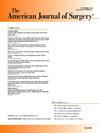免疫疗法时代肛门黑色素瘤的治疗模式。
IF 2.7
3区 医学
Q1 SURGERY
引用次数: 0
摘要
背景:肛门黑色素瘤(AM)是一种罕见的侵袭性癌症,生存率低,缺乏标准的治疗指南。方法:本研究分析了2004-2021年国家癌症数据库中的762例AM病例。主要目的是评估2011年FDA批准免疫疗法(IT)前后的治疗模式和生存结果。结果:2011年后,IV期AM患者的IT使用率显著增加(14% - 58%)。在社区和学术中心,腹部会阴切除术(APR)率在it后下降(49% - 31%,p < 0.0001)。对于接受IT治疗的患者,III期的中位总生存期从20.3个月上升到27.2个月(p = 0.0057), IV期的中位总生存期几乎翻了一番(6.7-13.3个月,p < 0.0001)。早期未观察到生存获益(p = 0.5712)。结论:在晚期AM患者中,IT的使用正在增加,与晚期患者更长的生存期和更低的APR率相关。本文章由计算机程序翻译,如有差异,请以英文原文为准。
Treatment patterns of anal melanoma in the era of immunotherapy
Background
Anal melanoma (AM) is a rare and aggressive cancer with poor survival and absence of standard treatment guidelines.
Methods
This study analyzed 762 cases of AM from the National Cancer Database during 2004–2021. The primary objectives were to evaluate treatment patterns and survival outcomes before and after the FDA approval of immunotherapy (IT) in 2011.
Results
The use of IT increased significantly after 2011 in patients with stage IV AM (14 %–58 %). Abdominoperineal resection (APR) rates declined post-IT (49 %–31 %, p < 0.0001), in both community and academic centers. For patients treated with IT, median overall survival for stage III rose from 20.3 to 27.2 months (p = 0.0057) and nearly doubled for stage IV (6.7–13.3 months, p < 0.0001). No survival benefit was observed in earlier stages (p = 0.5712).
Conclusions
IT use in advanced AM is increasing, correlating with longer survival and reduced APR rates in later stage patients.
求助全文
通过发布文献求助,成功后即可免费获取论文全文。
去求助
来源期刊
CiteScore
5.00
自引率
6.70%
发文量
570
审稿时长
56 days
期刊介绍:
The American Journal of Surgery® is a peer-reviewed journal designed for the general surgeon who performs abdominal, cancer, vascular, head and neck, breast, colorectal, and other forms of surgery. AJS is the official journal of 7 major surgical societies* and publishes their official papers as well as independently submitted clinical studies, editorials, reviews, brief reports, correspondence and book reviews.

 求助内容:
求助内容: 应助结果提醒方式:
应助结果提醒方式:


